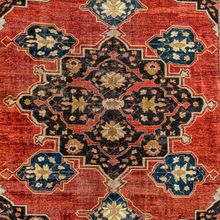Arak Rug
| Arak Rug | |
|---|---|
 Design of Arak Rug (Rugman) | |
| General information | |
| Name | Arak Rug |
| Original name | قالی اراک |
| Alternative name(s) | Arak Carpet (Sultan Abad) |
| Origin | |
| Category | City |
| Technical information | |
| Common designs | Herati , Medallion |
| Common colors | Crimson, Red, Navy Blue, Green, Cream, Beige, Blue |
| Dyeing method | Natural, Synthetic |
| Pile material | Wool, Silk |
| Foundation material | Cotton |
| Knot type | Asymmetrical (Persian) |
Arak Rugs originate from Arak, previously known as Sultanabad, is the capital city in the Province of Arak, located in north-central Iran. A center of agricultural trade, this great city is also known for pottery, metalwork, and hand woven area rugs. A very important region in the making of Persian area rugs, the roots of its commercial rug weaving industry can be traced back to the 17th century. After World War II the Province of Arak became known for a particular style of rug called the Sarouk. These very attractive area rugs, named after a village in the area, typically feature detached floral sprays in an all-over design on a red background. Arak rugs are woven using asymmetrical Persian knots. The quality of the rug is largely dependant on the number of knots per square inch and may vary from rug to rug.
History
Arak, formerly Sultanabad, is a city in west central Iran. Today Arak is the capital city of Arak Province. In this province are several important towns and villages that made carpets and rugs beginning in the mid-nineteenth century, some of which have achieved recognition in the carpet industry world-wide, such as Farahan, Lilihan, Mohajeran, Moshkabad, Sarouk, and Sultanabad, among many others.
In the 192os weavers in this region transitioned away from their traditional designs to those more attuned to the American market. By the late twentieth century many Arak Province weavers made carpets similar to those from other provincial Iranian cities and villages in accordance with the demand of foreign and domestic consumers.[1]
See also
References
- ↑ Moheban, 2015, 58
Bibliography
- Abraham Levi Moheban. 2015. The Encyclopedia of Antique Carpets: Twenty-Five Centuries of Weaving. NewYork: Princeton Architectural Press.